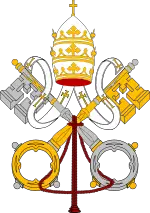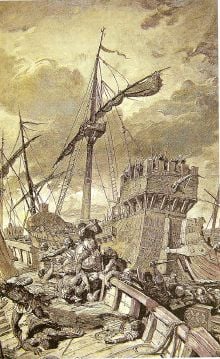Difference between revisions of "Pope Leo IV" - New World Encyclopedia
(New page: {{Infobox Pope| English name=Saint Leo IV| image=150px| birth_name=???| term_start=April 10, 847| term_end=July 17, 855| predecessor=[[Pope Sergius II|Se...) |
m |
||
| Line 21: | Line 21: | ||
A [[Rome|Roman]] by birth, he was unanimously chosen to succeed [[Pope Sergius II|Sergius II]]. When he was elected, on April 10, 847, he was cardinal of [[Santi Quattro Coronati]], and had been subdeacon of [[Pope Gregory IV|Gregory IV]] and archpriest under his predecessor. His pontificate was chiefly distinguished by his efforts to repair the damage done by the [[Saracens]] during the reign of his predecessor to various churches of the city, especially those of [[St. Peter's Basilica|St Peter]] and [[Basilica of Saint Paul Outside the Walls|St Paul]]. | A [[Rome|Roman]] by birth, he was unanimously chosen to succeed [[Pope Sergius II|Sergius II]]. When he was elected, on April 10, 847, he was cardinal of [[Santi Quattro Coronati]], and had been subdeacon of [[Pope Gregory IV|Gregory IV]] and archpriest under his predecessor. His pontificate was chiefly distinguished by his efforts to repair the damage done by the [[Saracens]] during the reign of his predecessor to various churches of the city, especially those of [[St. Peter's Basilica|St Peter]] and [[Basilica of Saint Paul Outside the Walls|St Paul]]. | ||
| − | [[Image:Battle of Ostia.jpg|thumb|left|220px|The Battle of Ostia in an 1829 engraving | + | |
| + | [[Image:Battle of Ostia.jpg|thumb|left|220px|The Battle of Ostia in an 1829 engraving]] | ||
| + | |||
The Saracens were sieging Gaeta, and then between 848 and 849 Leo had the walls of the city restored and strengthened. When the Muslims closed to [[Portus]], he summoned the [[Repubbliche Marinare]] or mariner cities of Italy: [[Naples]], [[Gaeta]] and [[Amalfi]] to form a league. The command of the unified fleet was given to [[Caesar of Naples|Cesarius]], son of Duke [[Sergius I of Naples]]. The subsequent [[Battle of Ostia]] was one of the most famous in the Middle Ages Papacy history, and is celebrated in a famous fresco by [[Raphael]] and his pupils in his [[Raphael Rooms|Rooms]] of the [[Vatican Palace]] in the [[Vatican City]]. Another episode of Leo's life celebrated by the [[Urbino|Urbinate]] in his series of frescoes painter is the ''Incendio di Borgo'': it depicts the great burning of the Anglo-Saxon district of Rome (the "[[Borgo (rione of Rome)|Borgo]]") which, according to the legend, was stopped by Leo simply making the sign of the cross. | The Saracens were sieging Gaeta, and then between 848 and 849 Leo had the walls of the city restored and strengthened. When the Muslims closed to [[Portus]], he summoned the [[Repubbliche Marinare]] or mariner cities of Italy: [[Naples]], [[Gaeta]] and [[Amalfi]] to form a league. The command of the unified fleet was given to [[Caesar of Naples|Cesarius]], son of Duke [[Sergius I of Naples]]. The subsequent [[Battle of Ostia]] was one of the most famous in the Middle Ages Papacy history, and is celebrated in a famous fresco by [[Raphael]] and his pupils in his [[Raphael Rooms|Rooms]] of the [[Vatican Palace]] in the [[Vatican City]]. Another episode of Leo's life celebrated by the [[Urbino|Urbinate]] in his series of frescoes painter is the ''Incendio di Borgo'': it depicts the great burning of the Anglo-Saxon district of Rome (the "[[Borgo (rione of Rome)|Borgo]]") which, according to the legend, was stopped by Leo simply making the sign of the cross. | ||
Revision as of 14:13, 24 November 2008
| Saint Leo IV | |
|---|---|

| |
| Birth name | ??? |
| Papacy began | April 10, 847 |
| Papacy ended | July 17, 855 |
| Predecessor | Sergius II |
| Successor | Benedict III |
| Born | ??? Rome, Italy |
| Died | July 17 855 ??? |
| Other popes named Leo | |
| Styles of Pope Leo IV | |

| |
| Reference style | His Holiness |
| Spoken style | Your Holiness |
| Religious style | Holy Father |
| Posthumous style | Saint |
Pope Saint Leo IV was pope from April 10, 847 to July 17, 855.
A Roman by birth, he was unanimously chosen to succeed Sergius II. When he was elected, on April 10, 847, he was cardinal of Santi Quattro Coronati, and had been subdeacon of Gregory IV and archpriest under his predecessor. His pontificate was chiefly distinguished by his efforts to repair the damage done by the Saracens during the reign of his predecessor to various churches of the city, especially those of St Peter and St Paul.
The Saracens were sieging Gaeta, and then between 848 and 849 Leo had the walls of the city restored and strengthened. When the Muslims closed to Portus, he summoned the Repubbliche Marinare or mariner cities of Italy: Naples, Gaeta and Amalfi to form a league. The command of the unified fleet was given to Cesarius, son of Duke Sergius I of Naples. The subsequent Battle of Ostia was one of the most famous in the Middle Ages Papacy history, and is celebrated in a famous fresco by Raphael and his pupils in his Rooms of the Vatican Palace in the Vatican City. Another episode of Leo's life celebrated by the Urbinate in his series of frescoes painter is the Incendio di Borgo: it depicts the great burning of the Anglo-Saxon district of Rome (the "Borgo") which, according to the legend, was stopped by Leo simply making the sign of the cross.
In order to definitively counter the Saracen menace, Leo ordered a new line of walls encompassing the suburb on the right bank of the Tiber to be built, including the till now undefended St. Peter's Basilica. The district enclosed by the walls is still known as the Civitas Leonina, namely the City of Leo. He also embellished the damaged churches of St. Paul and St. Peter's: the latter's altar received again (after the former had been stolen) his gold covering, which weighed 206 lb. and was studded with precious gems.
Leo held three synods, one of them in 850, distinguished by the presence of Louis II, but none of them otherwise of importance. The history of the papal struggle with Hincmar of Reims, which began during Leo's pontificate, belongs rather to that of Nicholas I.
Leo died on July 17, 855 and was buried in St. Peter's. Benedict III was Leo's immediate successor. A medieval tradition claimed that a woman, Pope Joan, succeeded him, disguising herself as a man; Joan is generally believed to be fictitious.
ReferencesISBN links support NWE through referral fees
- Cheetham, Nicolas, Keepers of the Keys, New York: Charles Scribner's Sons, 1983. ISBN 0-684-1863-X
External links
- Catholic Encyclopedia: Pope St. Leo IV
- Opera Omnia by Migne Patrologia Latina with analytical indexes
| Roman Catholic Popes | ||
|---|---|---|
| Preceded by: Sergius II |
Pope 847–855 |
Succeeded by: Benedict III |
| ||||||||||||||||
| |||||||||||||||||||||||||||||||||||||||||||||
| |||||||||||||||||||||||||||||||||||||||||
Credits
New World Encyclopedia writers and editors rewrote and completed the Wikipedia article in accordance with New World Encyclopedia standards. This article abides by terms of the Creative Commons CC-by-sa 3.0 License (CC-by-sa), which may be used and disseminated with proper attribution. Credit is due under the terms of this license that can reference both the New World Encyclopedia contributors and the selfless volunteer contributors of the Wikimedia Foundation. To cite this article click here for a list of acceptable citing formats.The history of earlier contributions by wikipedians is accessible to researchers here:
The history of this article since it was imported to New World Encyclopedia:
Note: Some restrictions may apply to use of individual images which are separately licensed.


